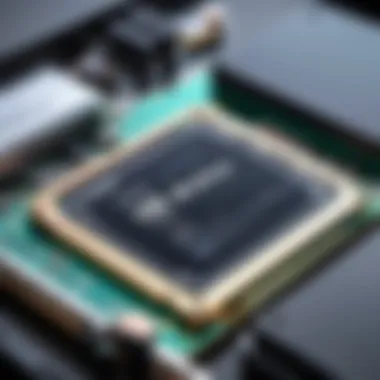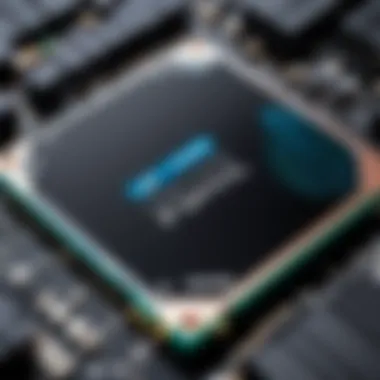Understanding NVMe SSD Pricing for 1TB Models


Intro
The market for NVMe SSDs has rapidly evolved over the last few years. A critical focal point within this realm is the pricing of 1TB models. Consumers often find themselves navigating a complex landscape where performance, brand reputation, and technological advancements play essential roles in determining price. This article aims to dissect current pricing trends, delve deep into the considerations for buyers, and present analyses that can guide tech enthusiasts and gamers toward making informed decisions.
As gaming and computing demands increase, so too does the need for storage solutions that can keep pace. Many seek the optimal balance between performance and cost-effectiveness. By understanding the myriad factors at play in the pricing of 1TB NVMe SSDs, consumers can appreciate what influences these costs. From emerging technologies to brand competition, prices fluctuate, which can leave consumers feeling lost. The analysis herein strives to clarify these variables, presenting current market trends and comparing popular brands to highlight differences that could impact buying decisions.
Accessibility to SSD technology might seem straightforward, yet the subtleties in price determinations can be intricate. The information in this piece is geared toward armoring readers with knowledge that transcends mere numbers; it offers insights into performance variations, enduring brand trust, and innovations that promise value for money when contemplating an NVMe SSD upgrade.
Preface to NVMe SSD Technology
In the ever-evolving landscape of computer storage solutions, NVMe SSD technology stands at the forefront. Understanding this technology is essential for consumers, particularly those looking into the nuances of storage performance and pricing. NVMe, which stands for Non-Volatile Memory Express, represents a significant advancement over traditional storage interfaces, offering superior speed and efficiency. With the increasing amount of data that users work with daily, a deeper knowledge of NVMe’s benefits provides indispensable insights for making informed purchasing decisions.
What is NVMe?
NVMe is a protocol designed specifically for SSDs that connects directly to the PCIe (Peripheral Component Interconnect Express) bus. Unlike the SATA interface, which was originally created for traditional hard drives, NVMe utilizes the full potential of modern flash memory. This results in lower latency and higher data transfer rates. In practical terms, NVMe drives are typically several times faster than SATA drives, dramatically improving system responsiveness, file transfer speeds, and overall performance. The protocol was introduced to address the bottlenecks of earlier standards and to optimize the capabilities of flash memory.
Advantages of NVMe over SATA
The advantages of NVMe over SATA drives are numerous and noteworthy. Key benefits include:
- Speed: NVMe interfaces provide significantly faster read and write speeds compared to SATA. This is particularly advantageous for demanding applications like gaming, video editing, or large data processing tasks.
- Parallelism: NVMe supports multiple queues and commands, allowing for better utilization of the drive’s capabilities. SATA, on the other hand, is limited to one command queue.
- Efficiency: Due to its design, NVMe drives generate less heat and consume less power than SATA drives. This efficiency extends battery life in mobile devices and ensures quieter operation.
- Scalability: Manufacturers can develop NVMe products that cater to various markets and use-cases, allowing for a wider selection of products with diverse features.
Understanding NVMe technology forms the basis for evaluating 1TB SSD models. As we move further into the article, we will analyze pricing, brands, and performance metrics centered around 1TB NVMe SSDs.
The Importance of Storage Capacity
In the realm of technology and data storage, understanding the significance of storage capacity goes beyond just the numbers. For consumers contemplating an upgrade to a 1TB NVMe SSD, grasping storage capacity is vital. This understanding influences purchase decisions and impacts overall system performance. The attributes of storage shapes the user experience in both gaming and productivity tasks.
When it comes to storage, the capacity of the drive determines how much data can be stored. A larger storage space means that users can keep more applications, games, and files without needing to constantly manage or delete content. This is particularly important for gamers who often deal with large file sizes for modern games, updates, and downloadable content. A 1TB SSD strikes a balance, offering sufficient room for typical users while remaining affordable.
Moreover, the efficiency of data retrieval is an important aspect of storage capacity. More available space typically translates to improved read and write speeds, particularly when the drive is not near full capacity. This performance aspect can make a noticeable difference in practical usage, especially in tasks like video editing, gaming, or running virtual machines.
Ultimately, understanding the importance of storage capacity serves as a foundational element for consumers making informed decisions about their storage solutions.
Why 1TB is a Popular Choice
1TB has emerged as a favored choice among tech enthusiasts and gamers alike. This popularity stems from a few factors. First and foremost, a 1TB SSD offers ample space without overcommitting on price. Gamers, for instance, often require larger files for their collections, and a single 1TB drive can hold a significant number of titles.
In addition to the cost-efficiency, 1TB drives are becoming a standard due to their ability to meet the growing demands of software. As applications increase in size and complexity, having a larger drive ensures that users do not need to manage space too frequently. The convenience factor cannot be understated. With a 1TB drive, users can install multiple software tools and store extensive datasets without constant anxiety over available space.
Furthermore, the broad adoption of 1TB drives by manufacturers signifies product reliability. Both performance and longevity are key attributes, making 1TB NVMe SSDs more attractive to users who rely on timely access to their files.
Considerations for Storage Needs


When evaluating storage needs, it is essential to move beyond capacity alone. Factors such as data usage patterns, the types of applications run, and future expansion plans all influence the ideal choice of storage.
For example, gamers should consider the size of their libraries. If they frequently switch games or engage with several at a time, a 1TB SSD might be the baseline they need. For users who primarily utilize basic applications, smaller capacities might suffice, but the trends indicate that more users opt for larger drives as a precaution.
User habits also matter. Those who find themselves storing multimedia files—such as videos, music, and images—would benefit significantly from the added space a 1TB SSD provides. On the other hand, professionals handling extensive datasets or large software installations regularly might prefer to go even higher than 1TB. Meanwhile, it's prudent for users to assess whether their needs might evolve, warranting a larger capacity in the future.
In summary, a thoughtful approach to understanding storage needs is necessary for optimal usage of an NVMe SSD, underscoring the importance of evaluating how one uses technology in day-to-day activities.
Current Market Price Trends
The realm of NVMe SSD pricing is very dynamic, making it an essential topic for consumers and tech enthusiasts. Knowing the current market price trends is crucial not just for budgeting but also for understanding what to expect when comparing models and brands. The pricing of 1TB NVMe SSDs varies widely, influenced by multiple factors. This analysis sheds light on these trends to assist in making informed choices.
Overview of Pricing Dynamics
In recent years, NVMe SSD prices have generally decreased due to technological advancements and increased competition among manufacturers. NVMe SSDs have become more accessible to a broader audience. Prices fluctuate based on several factors such as demand, supply chain issues, and product specifications.
Understanding these dynamics helps demonstrate why some models are priced higher despite similar specifications. For example, a brand may release a model equipped with newer technology, justifying a higher price point due to improved performance and longevity compared to older variants. Consumers should stay informed about these trends to avoid overspending on outdated technology.
Factors Affecting NVMe SSD Prices
Demand and Supply Influences
The laws of demand and supply play a vital role in determining prices in the NVMe SSD market. When demand rises, perhaps due to a surge in gaming or content creation needs, prices generally follow suit. Conversely, during periods of low demand, manufacturers may lower prices to stimulate sales.
A key characteristic of this dynamic is the rapid pace at which technology evolves. New models with enhanced features can become available quickly, creating a surplus of older models on the market. This scenario often leads to price reductions on the less sought-after products. However, timing is essential; waiting too long could mean missing out on features that significantly enhance performance.
Technological Advancements
Technological advancements are another driving force in NVMe SSD pricing. As companies innovate, new technologies are introduced into their products. These innovations may include improved read/write speeds, enhanced thermal management systems, or more efficient power consumption. Such enhancements can justify a higher price due to better performance.
A unique feature observed is the introduction of 3D NAND technology, which allows for higher storage capacities in smaller physical spaces. While this tech may come at a premium initially, long-term benefits often outweigh the upfront costs, especially for performance-critical applications.
Manufacturer Pricing Strategies
Manufacturers employ various pricing strategies to position their products in the marketplace. A particular approach includes value-based pricing, wherein the cost reflects the perceived value by consumers rather than solely production costs. For example, a brand with a strong reputation for reliability may command higher prices, as consumers associate their products with quality.
Additionally, promotional pricing strategies often occur to clear inventory or introduce new models. These strategies can present a good opportunity for consumers looking for bargains. However, discerning when these promotions occur requires vigilance and market awareness, which can sometimes be challenging for an average buyer.
"Understanding the interplay of demand, technology evolution, and pricing strategies is essential for navigating the NVMe SSD market effectively."
Comparative Pricing Analysis of Popular Brands
A thorough analysis of pricing among popular brands in the NVMe SSD market is essential for informed consumer decision-making. The competitive landscape varies significantly, with factors like specifications, performance, and warranty coverage to consider. Understanding these elements allows consumers to gauge where they get the best value for their investment. Furthermore, a comparative approach highlights brand strengths and weaknesses, assisting users in selecting the model that best aligns with their needs.
Brand A: Specs and Price Overview


Brand A is widely recognized for its high-performance NVMe SSDs. The 1TB model from this brand offers impressive read and write speeds, making it suitable for demanding applications like gaming and content creation. The MSRP for this model usually hovers around $120, but prices can fluctuate based on sales and market demand.
Key Specifications include:
- Sequential Read Speed: Up to 3500 MB/s
- Sequential Write Speed: Up to 3000 MB/s
- Endurance Rating: 600 TBW
These figures place Brand A at an advantage in terms of speed, appealing to tech enthusiasts who value performance. However, it is also essential to consider long-term durability since reliability can impact overall satisfaction.
Brand B: Specs and Price Overview
Brand B has carved out a niche in the NVMe SSD market with its focus on reliability and endurance. Their 1TB NVMe SSD is priced around $110, making it a competitive option for those seeking value without sacrificing performance.
Core Specifications are:
- Sequential Read Speed: 3400 MB/s
- Sequential Write Speed: 2200 MB/s
- Endurance Rating: 500 TBW
While Brand B does not quite match the peak performance of Brand A, it often excels in longevity and consistent performance over time. This makes it a strong candidate for users who prioritize dependability over maximum speed.
Brand C: Specs and Price Overview
Brand C takes a different approach by offering budget-friendly options without enormous compromises in performance. Their 1TB NVMe SSD is often found at around $90, which attracts budget-conscious consumers.
Highlighted Specifications include:
- Sequential Read Speed: 3200 MB/s
- Sequential Write Speed: 2000 MB/s
- Endurance Rating: 400 TBW
Despite being the more economical option, Brand C does ensure acceptable performance levels for typical usage scenarios. However, the endurance ratings suggest it might not be the best choice for heavy workloads.
Performance Considerations
Performance considerations are pivotal in evaluating NVMe SSDs, particularly for 1TB models. As tech enthusiasts and gamers seek optimal performance for demanding applications, understanding how these drives operate under various conditions becomes essential. Speed and longevity are the two primary factors that define user experience and device reliability. These elements play a crucial role in decision-making, influencing both initial purchase and long-term satisfaction.
Speed Testing: Real-World Results
When assessing the speed of NVMe SSDs, it is important to recognize that benchmarks can only provide a glimpse of real-world performance. Speed testing involves taking these drives through practical applications to measure how they cope with day-to-day tasks and intense gaming sessions. For example, load times in games, file transfer rates, and the impact on overall system responsiveness can all vary based on the SSD's specifications.
Key metrics include:
- Sequential read/write speeds: Indicative of how quickly data can be read from or written to the drive. Higher numbers suggest better performance during large file transfers.
- Random read/write speeds: Crucial for tasks that involve lots of small files, such as booting an operating system or launching applications.
Real-world tests often reveal that while certain models boast impressive specifications, the actual performance can differ greatly based on system setup, usage patterns, and thermal management. For gamers and power users, seeking out reviews that focus on these practical performance results provides a clearer picture of what to expect.
Longevity: Endurance Ratings Explained


Longevity is another paramount factor in performance considerations. The endurance of an SSD measures how long it will last under typical use. This is quantified through TBW (Terabytes Written) ratings, which represents the total amount of data that can be written to the drive over its lifetime. Generally, a higher TBW implies a more durable drive, capable of handling extensive workloads without failure.
Several considerations regarding endurance include:
- NAND type: Different NAND flash types, such as TLC, QLC, or MLC, exhibit varying endurance levels. For instance, MLC generally lasts longer than TLC.
- Usage patterns: Users who continuously write large amounts of data will impact the longevity more than those who use their SSDs predominantly for read tasks.
Understanding endurance ratings not only equips consumers with the knowledge they need to make informed purchases but also helps them align their storage solutions with their actual usage demands.
Evaluation of Value for Money
When investing in technology, especially in components like NVMe SSDs, understanding the concept of value for money is crucial. This section highlights why assessing value for money is essential for consumers, particularly tech enthusiasts and gamers. Value for money involves examining not just the price of a product but also the performance, durability, warranty, and post-purchase support. Making an informed decision can lead to significant cost savings and enhanced user experience.
Understanding Cost-Performance Ratio
The cost-performance ratio is an important metric for gauging the efficiency of an NVMe SSD. This ratio compares the price of the drive to its performance in tasks such as file transfers, loading times in games, and application boot speeds.
Factors to consider in this assessment include:
- Read and Write Speeds: A higher ratio tends to accompany drives that offer better speed performance at a reasonable price. Consumers should compare the speeds advertised by the manufacturer with real world tests.
- IOPS (Input/Output Operations Per Second): This measure indicates how many operations the SSD can perform in a second, directly impacting the daily performance, especially for multi-tasking.
- Endurance Ratings: Drives with high endurance ratings often represent better value for money, as they last longer under heavy workloads.
Evaluating these factors can help consumers select an NVMe SSD that delivers the best performance per dollar spent. Always refer to benchmarks and reviews from trusted sources to get a clearer picture.
Assessing Warranty and Support Options
Warranty and support options are more critical than often realized when evaluating the overall value of NVMe SSDs. A longer warranty can signify the manufacturer’s confidence in their product.
Consider the following aspects when assessing warranty:
- Length of Warranty: Many manufacturers offer warranties ranging from three to five years. A longer warranty may indicate better durability and reliability.
- Type of Warranty: Ensure to understand what the warranty covers. Some warranties might only cover manufacturing defects, while others might include support for performance issues.
- Customer Support Availability: Products with responsive customer support can enhance the ownership experience significantly. Check reviews to see how previous customers rate the service.
In summary, warranty and support options are fundamental to ensuring that your investment remains secure over time, protecting against failures or defects.
Finale and Recommendations
In this section, we will explore the significance of concluding remarks and recommendations derived from the analysis of NVMe SSD pricing. The focus will be on synthesizing key insights, which can guide consumers in their purchasing choices. This article has examined various facets of NVMe SSDs, particularly 1TB models, illuminating the market dynamics that influence pricing and value.
Understanding the overall pricing landscape is crucial for anyone considering an upgrade. The analysis not only reveals how different brands position their products but also highlights what consumers can expect in terms of performance and longevity. A well-informed decision minimizes the risk of buyer's remorse and ensures that the investment is wise in relation to the technology requirements.
Key Takeaways from the Analysis
- Market Trends: The NVMe SSD market continues to evolve rapidly, driven by advancements in technology and shifts in consumer demand. Keeping abreast of these trends can aid in timing the purchase for optimal pricing.
- Performance vs. Price: There is a direct correlation between the specifications of SSDs and their price points. Higher speeds and enhanced durability often come at a premium, but may offer significant advantages in specific use cases, such as gaming or data-intensive tasks.
- Brand Comparison: Not all brands provide the same value. Brand reputation, warranty offerings, and support should be factors in the purchase decision, along with raw specifications and prices.
- Consumer Needs: Understanding personal storage requirements is fundamental. While 1TB may be adequate for many users, serious gamers or content creators may need to assess their needs more critically to avoid future upgrades.
"A good purchase is one where the technology meets the user’s specific needs, balancing performance and cost effectively."
Final Thoughts for Consumers
As we wrap up this analysis, consumers should take the time to reflect on their usage patterns and future needs. If speed and responsiveness are paramount, investing in a high-performance NVMe SSD can yield benefits that justify the cost. Conversely, budget-conscious buyers may find satisfactory alternatives that balance cost with acceptable performance levels.
It's paramount to conduct thorough research before making final decisions. Comparing prices, studying performance benchmarks, and reading reviews are all integral steps in this process. Furthermore, considering warranty length and customer support quality from different manufacturers can provide peace of mind long after the purchase is made.
Overall, the insights from this article provide a solid foundation for navigating the often-confusing terrain of NVMe SSD purchases. Armed with knowledge about pricing dynamics, performance metrics, and brand specifications, consumers can approach the market more confidently, ensuring their next upgrade aligns with their technology goals.



